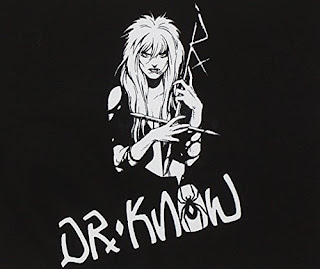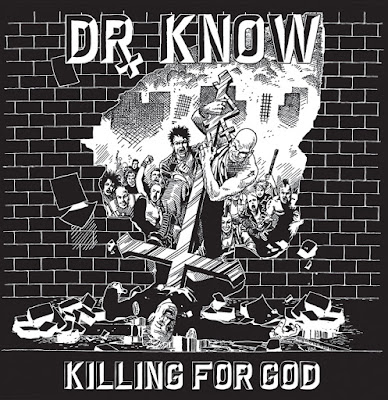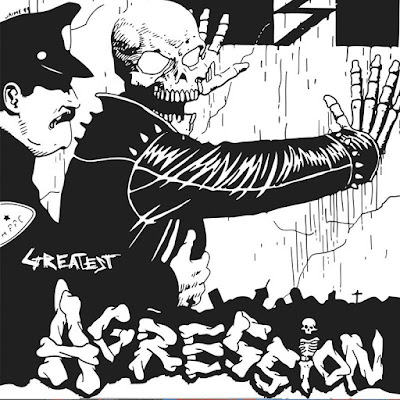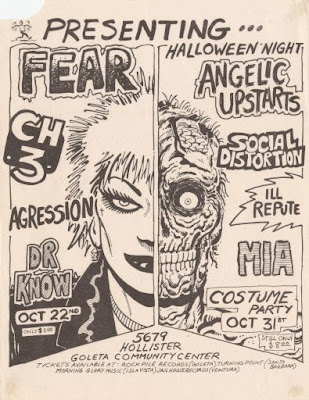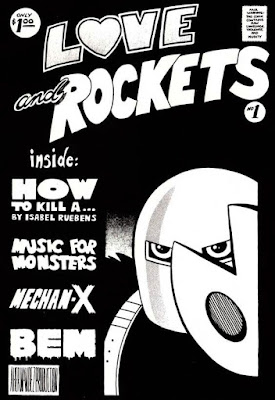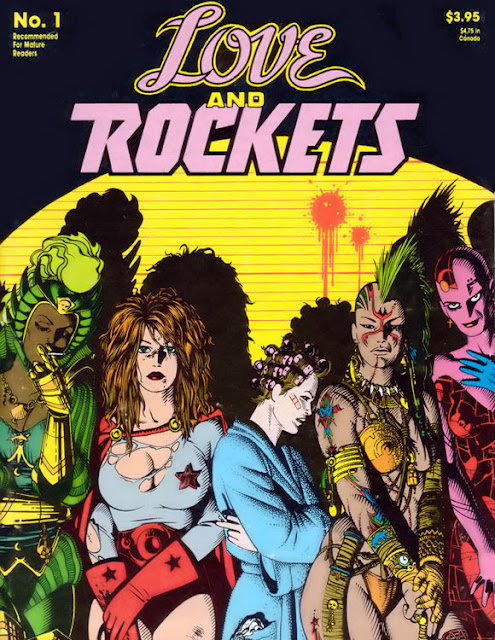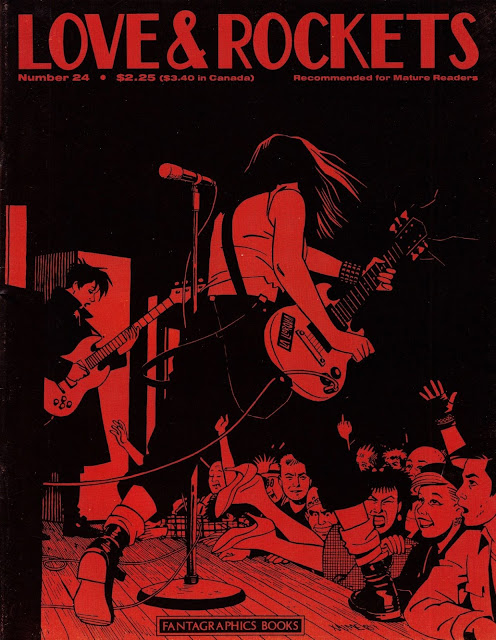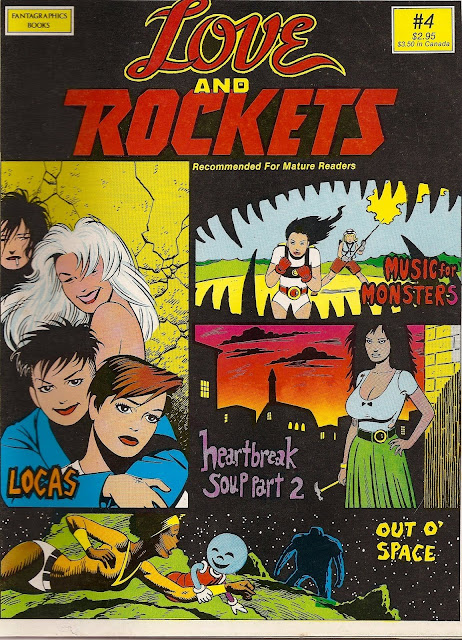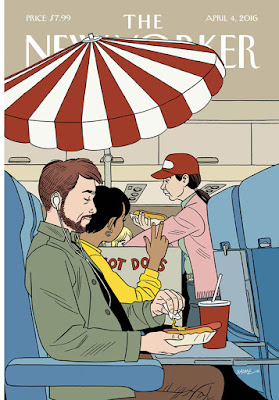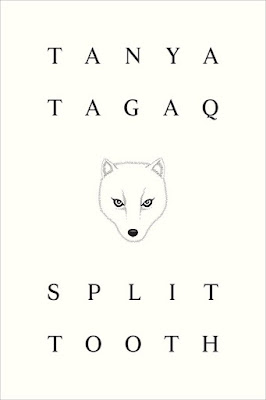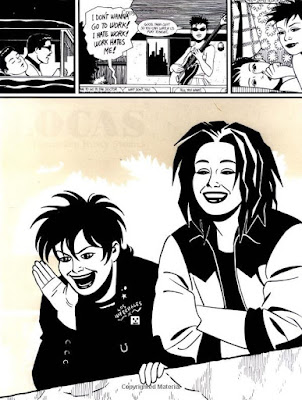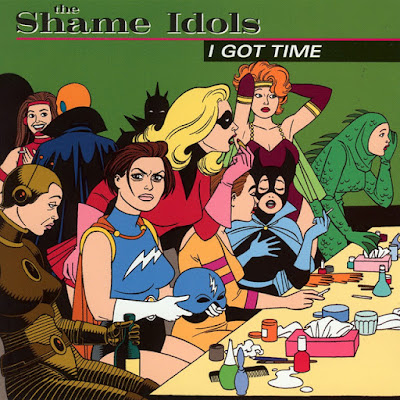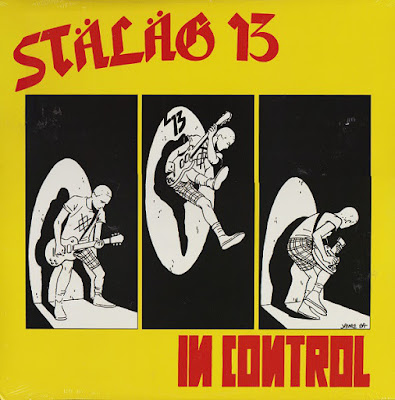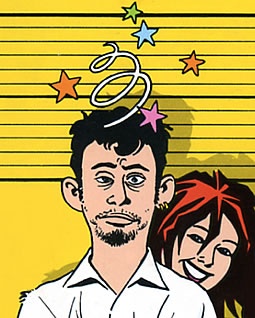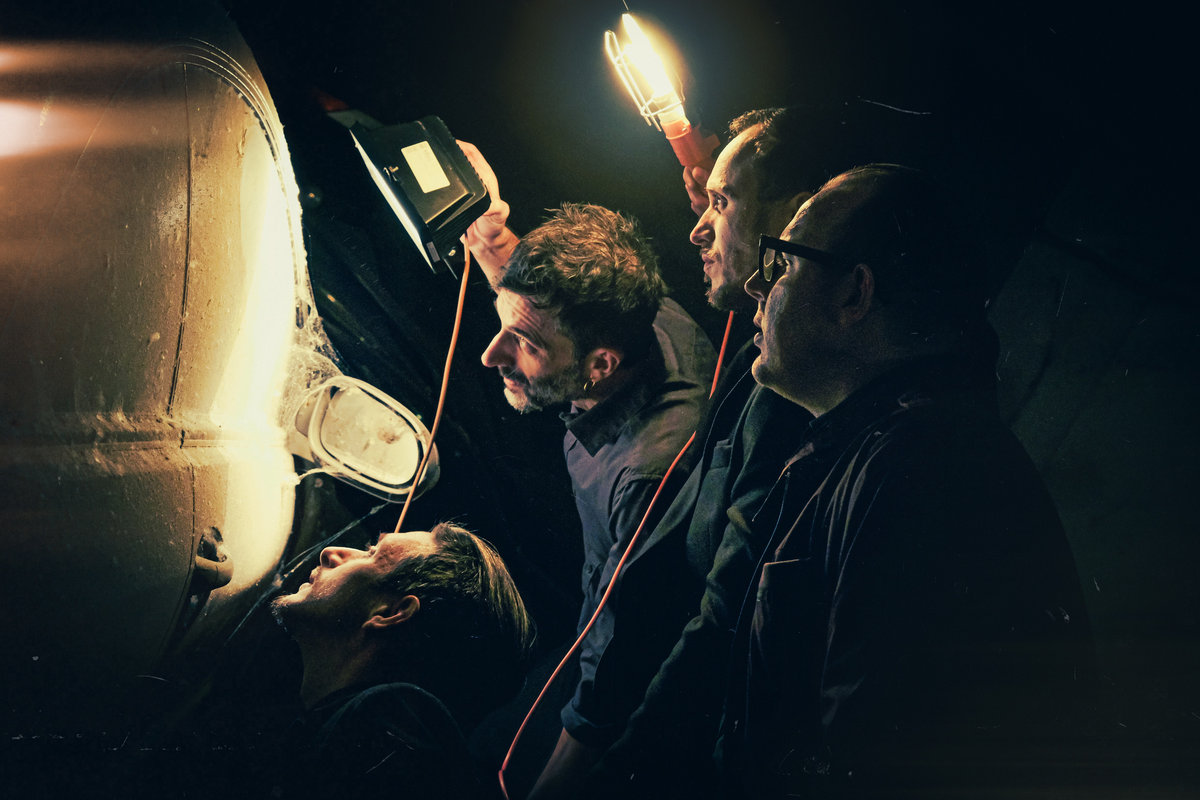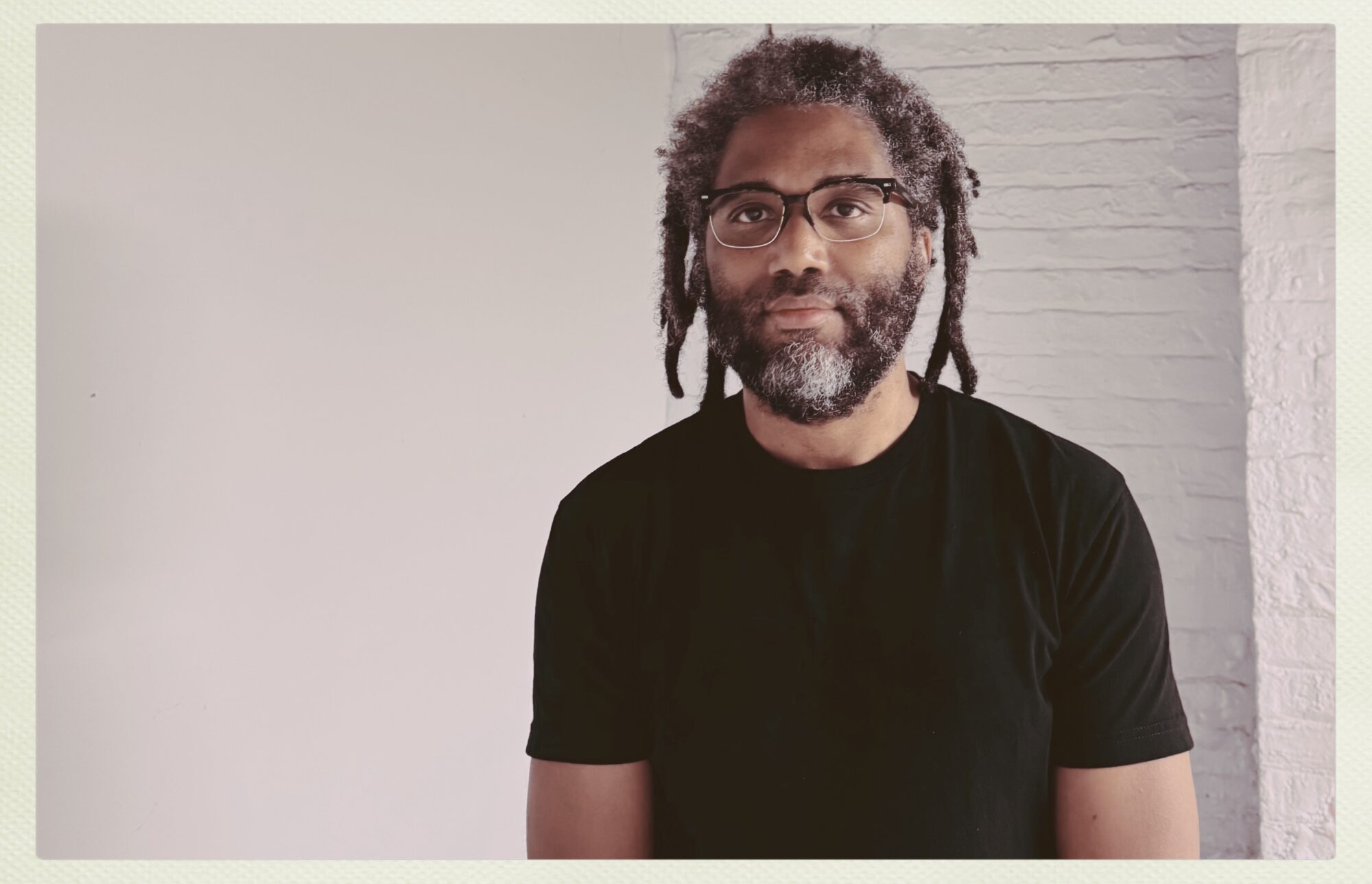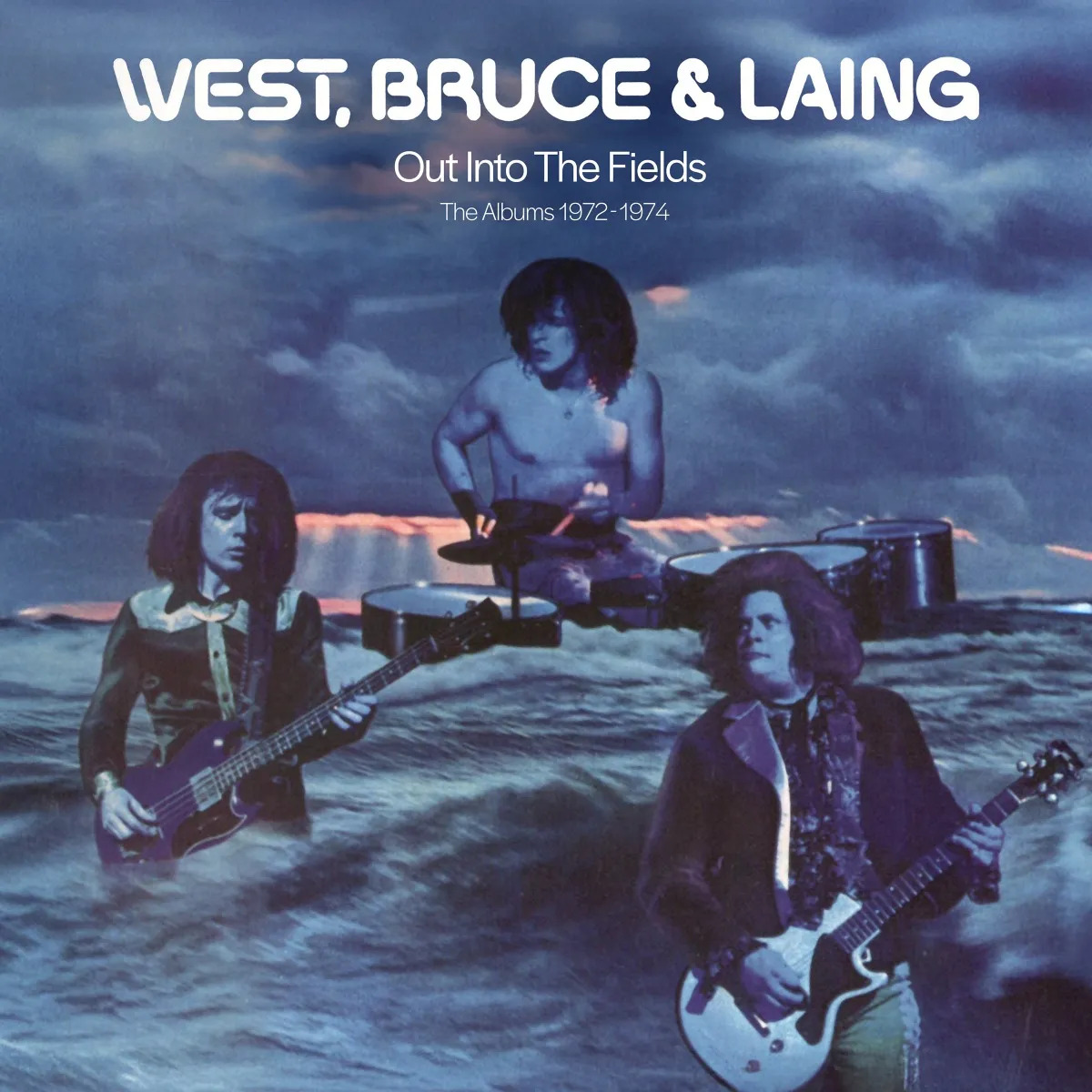An Interview with Jaime Hernandez
Him, and Gilbert and me would hang out with punks, and Ismael saw a friend in high school that he kinda knew–and the guy had a Clash button on…and Ismael was like: “At Oxnard high school???–That’s a strong kid!” And then Ismael and this guy kinda hooked up, and then Ismael was introduced to Kyle, the guitar player of Dr. Know. That was about 1981…‘82…maybe earlier…I can’t remember exactly. He hit it off with these two guys and they said: ‘We’re starting a band–we need a bass player!’ So my brother decided: “Okay, I’ll learn bass.”[laughs]
And then, from there, how did you come to design some Dr. Know album cover art, as well as art for other Nardcore [Oxnard Hardcore] bands–like Ill Repute and Agression (sic)– that were on the Mystic Records label?
Before that, we [Jaime and Gilbert] were doing flyers, too. It was pretty obvious…Gilbert and I were the ones who drew…so they always came to us. You know, punk flyers were usually paste-ups of photos and letters. When Raymond Pettibon did the Black Flag flyers, it made a lot of sense…it was kinda like, comics and punk! And I really liked that he drew their flyers. And, so, it kinda became obvious that that’s how you make flyers–you draw ‘em. That’s how it came about for me.
So, Raymond Pettibon was an influence, then?
Yeah, because I remember going to shows in L.A., and then you come out, and someone’s passing out flyers. And in those days, Black Flag numbered their flyers…so, I thought, these are like collectors’ items!
And now they are!
So, I thought, I’m gonna try to get as many as I can! But I could only get to L.A. once a week…or once a month…so, I’ve got some of their early ones [Black Flag’s flyers]… like no. 11, no. 12, some like that. But I just liked that idea, and I go, yeah, you should draw your flyers–that’s cool…it’s like comics! So, it was like, well, if you can draw, why not?’ And so Gilbert and I were the artists of our group–of our scene–and they would always come to us.
And at this same time were you and Gilbert also doing little spot illustrations for comics fanzines like The Comics Journal and other publications?
Yeah, Gilbert and I were still trying to somehow find a way to get in to comics. Though we didn’t want to follow the rules, so we would just do spot illos ‘cuz it was like: ‘Hey, I’m published!’ [laughs] So, it was kinda like that…and it was kinda like: ‘Hey, this doesn’t make us any money, but I love it that my stuff is out there!’ And shortly after was when we got that idea to make our own comic.
Let’s talk about that. How long did it take you guys to actually put together your very first issue of Love and Rockets?
I can’t remember…I do remember Gilbert was already working on “B.E.M.”…he had been working on it, but it was unfinished, because he didn’t know where it was going to be published, or where we was going to send it. It was like, he was just doing it–almost for himself, you know? And I had been designing characters–like Maggie…when I became punk, Maggie became punk! She cut her hair. She was a rocket mechanic at first, then I kinda made her a punk rocket mechanic. [laughs] And so, when our older brother Mario had the idea, like: “Hey, I know someone who can print this and make a comic.” Gilbert and me were like: “Okay,” and they just assigned me a certain amount of pages. And I did it fresh. I said, okay, I’ve got this character named Maggie, and she’s a rocket mechanic and she’s a punk. I don’t remember exactly how long it took us–but not that long.
And then after you sent a copy of your first self-published Love and Rockets comic to Gary Groth at The Comics Journal, he pretty much said: ‘This is great–we want to republish it and distribute it!’ –correct?
Yeah–it was that easy. Gilbert sent him a copy to be reviewed in The Comics Journal–and Gary wrote back saying: “We like this–can we publish this?” And overnight we were like: “Okay..,” and we’ve been with them [Fantagraphics Books] ever since.
Okay! I’ve always loved your iconic cover to Love and Rockets no. 1 [the first Fantagraphics Books-published issue] but I’ve always been curious about some of the female characters depicted in the police line up. Were some of them never used in any of your stories…like the cyber-punk looking woman…is she based on one of Gilbert’s characters from the “B.E.M.” story?
I think what we were trying to do was put every genre of comic in one cover–but the woman in the middle with the curlers [in her hair] and the robe kind of represented that you may think you know what you’re getting …but this is different. The superheroine in the cover lineup was used later…
Isn’t she called Comrade 7?
Yeah. But the rest of them…they were just…never used.
Have you ever thought of putting them in something–like even just a little short story?
I remember Gilbert was thinking of doing short stories with the characters…but they just never turned out.
Okay. Well, let’s talk about ‘Maggie’ Chascarrillo and ‘Hopey’ Glass and some of the main characters in the “Hoppers” Universe, so to speak–or the Jaime Hernandez universe–who inhabit most of your stories (as differentiated from Gilbert’s or Mario’s stories) in Love and Rockets. When you made the decision–after the first few issues–to transition from sci-fi-based stories of Maggie as a pro-solar mechanic to a more realistic depiction of Maggie and her punk rock friends, what was your main catalyst for that? Was it due to your own experiences in–and an homage to–the Oxnard punk rock scene?
Yeah–I was finding out that my real life was becoming more interesting than rockets and robots. The characters were important to me…[it was] more important to create the lives of these characters, and the dinosaur got in the way, basically I don’t wanna do a dinosaur because you’re not going to take this seriously, if someone’s life is in danger, or if someone’s going through an emotional down. You know, you’re not gonna really care if all of a sudden the dinosaur walks in and they go: “Yeeeek!!!” And another thing was kind of challenging ourselves and challenging the readers, that, I’m gonna make you be entertained by normal people on the street, as much as you are by some fantastic fantasy. And it was kind of a challenge, you know, so that was another thing.
And did you guys pretty much decide from the start that you were going to do it “Gasoline Alley”-style–for lack of a better phraseology–in terms of aging your characters in real life time (like the famous Gasoline Alley newspaper comic strip by Frank King) instead of keeping them forever young?
That kind of happened more naturally… I know Gilbert was influenced by Gasoline Alley and he liked how they aged, but I think we were already thinking that, if these are real characters–then someday they’re going to be old…so I think it was a mixture of both. Because I used to think the Gasoline Alley thing was it–like that’s where we got it from…but I’ve looked at old sketches that I did before Love and Rockets, and I have a Maggie aging chart…so it made me rethink this…and I’m thinking it just seems natural, in a way.
Well, let’s build off that…were some of your Love and Rockets character based off of people you knew…or did you try to inject parts of your own personality into the Maggie and Hopey stories?
Yeah–nobody specific…but I borrowed personalities and fashion styles. I created someone simply because I liked the haircut…I created somebody because I wanted an ‘Eeyore type’ [as in the character Eeyore from the Winnie-the-Pooh books by A.A. Milne], like a crabby person… and their personality built up around that. I like that this character dresses all in black.
Like your character Isabel “Izzy” Reubens?
Yeah. So, it almost never comes from a specific person, just something someone wears, or a personality type…things like that…
I remember back when I was first getting into Love and Rockets, one story in particular that really stunned me, because it was so well done, was “The Death of Speedy Ortiz.” How did that story come about?
I remember, one, I wanted to do a story about my Lowrider days. I was doing a lot of punk stuff…and I was like, yeah, but I kinda miss my days before punk, too, because they were just as fun. And so I thought, I wanna have one where they just hang out and cruise, and stuff like that. So, I had an idea that I’m gonna show street life, and my other childhood at that point…and also at the time I wanted to kill a character…I wanted a character to die. And I picked him.
Why him?
It just worked out…I mean his life was spiraling…you know, he started to get crabby and got kinda mean, and things were not going his way…
Yeah, I kinda remember that…like he was hitting on Maggie, and she was kinda rebuffing him, and trying to get with her younger sister, Esther, and in the back of the fast food restaurant in one scene, “Speedy” was screwing some other chick…Blanca…
Yeah…
But still I was kinda surprised when that happened, and I did think in some ways it was a moving story, because even though “Speedy” Ortiz was a troubled person, it seemed to me that he came across as a real person…having flaws and all of that, because prior to that you don’t have that many examples of this in comics…I mean maybe Denny O’Neil’s characterization of Roy Harper as a junkie in DC Comics’ Green Lantern/Green Arrow title in the early ‘70s. Also, I guess “The Death of Speedy Ortiz” story in some ways was a validation of the humanity of a character from a cultural group–Chicanos–that had not been given much of a voice up to that time in comics?
Yeah.
As far as you know, were you the first comic book writer/artist to create stories that explored the Lowrider Chicano subculture?
Probably not the first, but in comics one of the first…
How much of an influence did the American underground comix scene from the late ‘60s -late ‘70s have on you and Gilbert when you started Love and Rockets? Were there particular underground comix artists you liked?
Yeah, [Robert] Crumb, and [Gilbert] Shelton…and “Spain” [Manuel Rodriguez]…and Robert Williams. They were out there, and they were kinda a springboard for doing your own shit…for doing it your way…without any rules…‘cause, you know, when our comic started in the early ‘80s, Marvel had a stranglehold on everything! You had to do it their way or you were not gonna be published. But we had other ideas, and so did a lot of other people. I think when our comic was published, there were a lot of cartoonists going: “I wanna get my stuff published, too!” –so they started coming out of the woodwork. They had always been doing stuff, and they just had nowhere to go. And then they got published, like we did…so we kinda helped bring everybody out of the shadows.
Who were some of your peers from that time?
People like Peter Bagge, and Charles Burns–you know, that’s what I thought, I don’t know what they thought!
What about female cartoonists?
Yeah, there were female cartoonists as well. There was Mary Fleener, and Roberta Gregory…
Carol Lay?
Carol Lay had already been doing stuff…I remember her from way before we started. Yeah, and they [other alternative comics artists] were being published, too, but there was not an alternative market to support it. So, I think it didn’t become a community until the early ‘80s, when everyone started to have the support. Someone might tell you different–but this is my story.
So, beyond Love and Rockets, what can you tell me about some of your other projects–like the children’s book, The Dragon Slayer: Folktales from Latin America; and haven’t you been doing some things for The New Yorker magazine from time to time?
I did The New Yorker through the ‘90s–now and then. They stopped calling after awhile.
Why?
I dunno…they had other cartoonists that worked faster…I dunno.
Somebody at The New Yorker doesn’t know what they’re missing!
From The New Yorker and Raw [magazine] I met Francoise Mouly, who had Toon Books [an imprint created to publish age-appropriate comics for children] and she had asked me years ago if I would ever do a Toon Book, and I thought, yeah, that’d be great…do a kid’s book, that’d be great–but I hadn’t an idea. And then we finally came together a year or two ago, and we talked about it, and she had this idea for a book. I thought, good, I don’t have to come up with anything! [laughs]. Yeah, so we got together and we researched old [Latin American] folktales and we chose ones to do. Basically, it was as simple as that.
Based on this book’s publication do you see yourself going more in this direction–doing more books for children? I could see this book being a nice addition to a lot of public school libraries in California and other states–and even internationally.
Yeah, I think it’s a great idea and a good place to go, but right now I’m really focusing on Love and Rockets–as a magazine–again. Trying to get back on schedule. At the same time I’m illustrating a book for someone…as we speak…we’re almost to the end of it.
Can you talk about that or is it under wraps?
It’s officially been announced just in the past couple of days. It’s a book [Split Tooth] by a woman [Tanya Tagaq] from the Great White North, who grew up Inuit–and she’s from really high up in the snow. She’s also a pretty famous throat singer…
Like a Tuvan throat singing kind of thing…?
I don’t know what you call it, but throat singing… [laughs]…yeah. And it turned out that she was a fan of my comic. And one day she said: “Would you like to illustrate? — I’m writing a book.” And she was kinda nervous about it and was, like, I don’t know if my writing is good or whatever… but she found a publisher, and the first person she thought of to illustrate it was me. And I thought, cool! And so, I’ve been learning a lot about her culture…it’s just this really cool story–she tells really great stories–and I get to do a few illustrations in it. I’m really glad that she trusted me with it, because I didn’t really know that much about her world–and I’m learning a lot.
So, it was probably an exploration for you, too, learning about her and her cultural background?
Yeah! And it was a little…different…because she’s telling really personal stories–and I’m, like, are you sure you wanna trust me with this…? [laughs]. And she’s totally into it. So, if she’s okay with it, I’m okay with it…and I think it’s gonna come out really well and I’m really happy with the stuff. Working with someone else is just–I’m not as comfortable–so, it took me awhile to get into doing it–because Love and Rockets is my own thing, and if I mess up–I’m the only one to blame, you know?
I want to circle back to Love and Rockets, but I’d also like to ask about the recent Doom Patrol variant cover you did for Gerard Way’s DC Comics pop up imprint–Young Animal Comics–feturing Way’s new iteration of the Doom Patrol. Would you be interested in doing more work for DC Comics…are there old silver age characters that were your favorites as a kid that you’d enjoy…like, if you were given complete control for an independent story or one-shot special?
You know, when I was younger I would have…but now, not really. I mean, for one reason…say you grew up on The Doom Patrol… why wouldn’t you want to do The Doom Patrol? Well, Bruno Premiani did an excellent job –what do they need me for?
So you feel like it would be redundant?
Yeah, like if they asked me to do the old [Stan Lee and Jack] Kirby Fantastic Four– could I top that one?! [laughs]
But you did do a short, retro-‘60s Marvel Comics story, right? With the Wasp and the Scarlet Witch and…who was the villain…didn’t he have a crush on them? That must have been fun, I guess, right?
The Space Phantom! That was a lot of fun–but, you know, it was all fluff. So, I guess , yeah, in a way I did do characters I wanted to do. I mean, when I was young, I drew the best Wonder Woman that ever lived! But now, I’m like, eh, you don’t need me…
Back to Love and Rockets, I’ve noticed that in the last few issues of the comic you have gone back to relating some stories of Maggie and Hopey and their punk rock and cholo circle of friends when they were in their teenage years–besides the present day stories of them as middle-aged women. What prompted that decision?
With the flashbacks I wanted to show Maggie and Hopey in love–meaning the ‘I can’t live without you’ love–because I think it’s always been implied, but I’ve never actually really shown it.
I always thought, at least in the first run of Love and Rockets–from the 1980s–that Hopey’s love was deeper…that Maggie was kind of a free spirit and in love with love and experiencing new lovers… like, besides her relationship with Hopey, when she fell for the prosolar mechanic Rand Race in the very early sci-fi-based stories, or when she was romantically involved with the artist Ray Dominguez…
Well, basically, I guess you could spell it out as this… Hopey is lesbian and Maggie is bi-sexual…and there was a time when I toyed with the idea that you can’t really pin Maggie down. She is madly in love with Hopey, and it has nothing to do with her gender or whatever…she’s fixated on this one person…but, however you want to read it is fine.
Since Love and Rockets was so groundbreaking culturally as a series, all these years later, have you had many instances of younger creators coming up to you in the comics industry who are a part of the LGBTQ community and saying what an influence you and your work has had on them and their work or their lives?
Sure. I’ve had creators, I’ve had readers come up…and it’s great! Especially from queer women–because that’s one thing I cannot personally be, you know? I mean, a Mexican that grew up in Southern California comes up to me–and I go: ‘Well, that’s exactly what I am…so I know exactly what I’m talking about.’ Dealing with women–I don’t know everything about women. Dealing with queer women–I don’t know everything about queer women. I just do my best. And when someone comes up to me about that and says what a wonderful job I do, I’m thrilled to death because I did something right!
Would you attribute that at all to just having grown up in a really loving household with a mother who was a very compassionate person, or having sisters as well–or is it just something innate to you as a person, that you were able to do that?
It’s just mostly observing…and…uh…trying to put myself as close to it as possible without being it.
Okay. Moving back to music, I know that beyond the Nardcore bands, you’ve done some album art for bands including Los Lobos, 7 Year Bitch, The Makers, Indigo Girls… have you done anymore album covers or record art at all?
Not recently, but I just did a poster for a band called Speedy Ortiz.
A band named after your Love and Rockets character you killed off? Wow! Are they punk rock?
I guess so–I don’t know how to label this stuff any more! [laughs] I just know they have a brand new album and they asked me to do the art…so they’re selling posters…t-shirts with my image.
What did you draw for them?
The members of the band with a horse.
Okay, going back to your first album cover designs,–what’s your favorite Nardcore album art you did? I remember my cousin, Bert, and I thinking the Stalag 13 album cover was really cool we we first saw it!
It’s hard to say…not really a favorite…but I remember thinking the Stalag one was the most interesting because they just wanted three panels of a guy leaping with a guitar.


